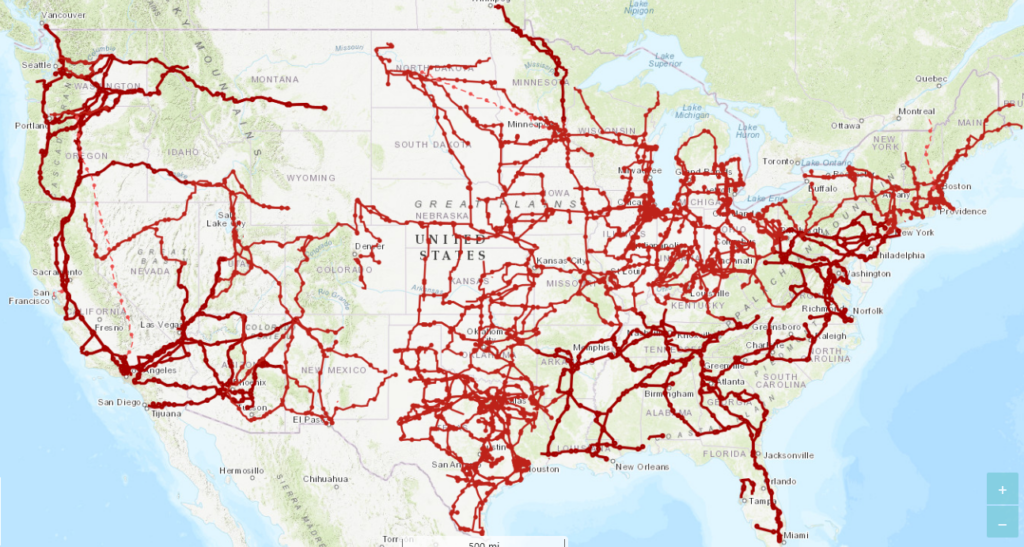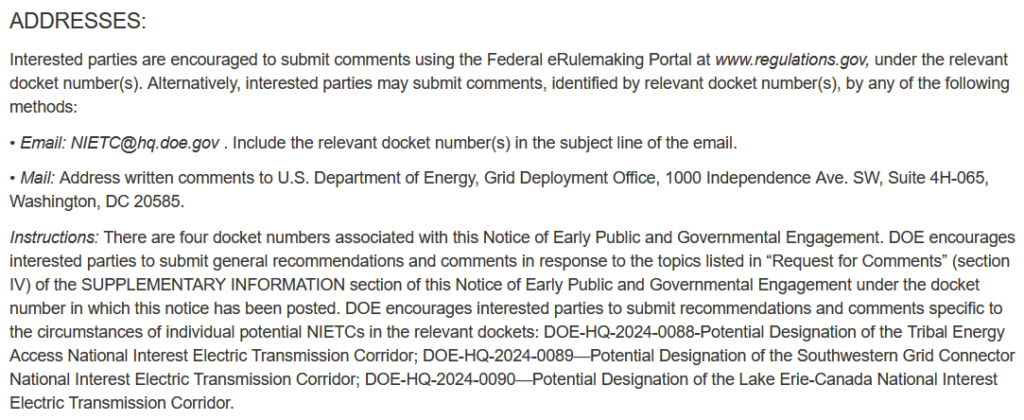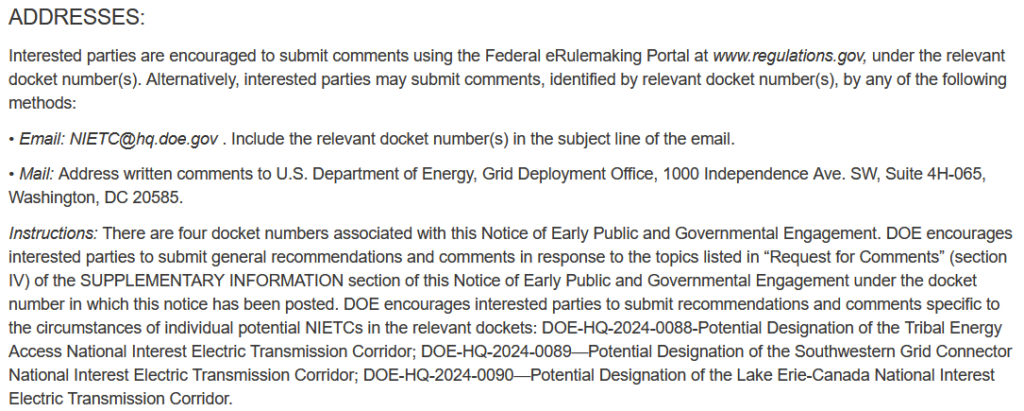Hot off the Press — Push for NIETC Transmission
December 16th, 2024
FYI, not related, here’s a close-up of Minnesota, transmission maps found at https://gem.anl.gov/tool/ and click on the transmission layer (takes a while to load):
A press release just hit the inbox, days after Oklahoma was able to stop declaration of a National Interest Electric Transmission Corridor through the state — the DOE withdrew the designation. Good idea.
A massive power transmission line project was canceled following public outcry
So here they go, pushing this — deja vu all over again:
Federal Register publication HERE.
It doesn’t say “Send comments here” so… it does say “for more info: Christina Gomer, Senior Technical Advisor, by email at NIETC@hq.doe.gov or by telephone at (202) 586- 2006.” I’ve sent a missive to clarify, but ?? Will post here when/if I hear something new.
HA! Here’s the response that I received:
There’s no “addresses” section of the Federal Register Notice that I can find. Here it is, see for yourself: https://www.govinfo.gov/app/details/FR-2024-12-16/2024-29419/summary
HERE’S THE INFO, from the link above (https://www.regulations.gov/document/DOE-HQ-2024-0096-0001), which is NOT linked in the Federal Register Notice:
Color me pissy…
Here are the 3 corridors they’re talking about. The one crossing the border into Canada at the right hand side of that “Lake Erie-Canada Corridor” label is short, pretty tough to see, so click on the map for a version you can enlarge.
Here’s how they fit with other big transmission — the proposed NIETC corridors are the blue lines on this map:
Anyway, below cut and pasted from the DOE press release in its entirety. Comment period is OPEN. Check this out and COMMENT, here’s the poop, and NOT in the Federal Register Notice:
Biden-Harris Administration Announces Three High-Priority Areas Advancing in National Interest Electric Transmission Corridor Designation Process
DOE Seeks Public Input on Proposed Public Engagement Framework and Possible Scope of Analysis for Areas Moving to Phase 3 of Designation Process
WASHINGTON, D.C. – In a continued effort to expedite the build out of a resilient and reliable electric grid, today the U.S. Department of Energy (DOE) released a list of three potential National Interest Electric Transmission Corridors (NIETCs) moving to the next phase of the designation process. A NIETC is an area of the country where DOE has determined the lack of adequate transmission harms consumers and the development of transmission would advance important national interests in that area, such as increased reliability and reduced consumer costs. DOE recently established a four-phase process for NIETC designation; the potential NIETCs moving to Phase 3 of the designation process are:
- Lake Erie-Canada Corridor, including parts of Lake Erie and Pennsylvania
- Southwestern Grid Connector Corridor, including parts of Colorado, New Mexico, and a small portion of western Oklahoma
- Tribal Energy Access Corridor, including central parts of North Dakota, South Dakota, Nebraska, and five Tribal Reservations
These potential NIETCs have been significantly refined since the release of the 10 potential NIETCs in May 2024, and each were renamed to better describe their location and purpose. DOE made these refinements in response to comments received from the public and its continued analysis of the value of NIETC designation to spur needed transmission investment.
A lack of transmission infrastructure can directly contribute to higher electricity prices, more frequent power outages from extreme weather, and longer outages as the grid struggles to come back online. In 2021, the Bipartisan Infrastructure Law amended the Federal Power Act to authorize the Secretary of Energy to designate any geographic area as a NIETC if DOE determines that consumers are currently harmed by a lack of transmission in the area or are expected to suffer harm from a lack of transmission in the future. DOE may also consider whether development of new transmission would advance important national interests for that region, such as increased reliability and reduced consumer costs, when designating NIETCs.
In December 2023, DOE’s Grid Deployment Office announced a new four-phase process for designating NIETCs. The process aims to maximize opportunities for public input throughout each of the phases to help DOE identify narrow geographic areas where transmission is urgently needed and where NIETC designation could help accelerate solutions.
DOE initiated the first phase of the new process by opening a public comment window for suggestions on where DOE should consider designating NIETCs. In May 2024, DOE initiated Phase 2 of the process by releasing a preliminary list of 10 potential NIETCs, including maps with rough approximation of boundaries and a high-level explanation of the transmission needs within the potential NIETCs. DOE also opened a public comment window.
The announcement today initiates Phase 3 of the designation process, the public and governmental engagement phase, during which DOE will continue to refine geographic boundaries, determine the appropriate level of environmental review for each NIETC, if any, and conduct any required environmental reviews under the National Environmental Policy Act (NEPA) and other applicable federal statutes, conduct robust public and governmental engagement, and prepare draft designation reports.
Additionally, DOE is aware of potential impacts to military testing, training, and operations and will continue working with the DoD Military Aviation and Assurance Siting Clearinghouse to address these impacts as these potential NIETCs are further refined in Phase 3.
DOE is also publicly releasing detailed maps of each of the three potential NIETCs moving to Phase 3, including underlying geographic information system data. A 60-day comment period is now open to solicit comments on DOE’s proposed public engagement framework and possible scope of analysis of the potential NIETCs, including environmental, cultural, or socioeconomic effects should DOE designate any of the potential NIETCs. Additional public engagement will occur after this initial comment period. In addition, DOE is providing the names of known transmission projects under development within the potential NIETCs, as well as anticipated next steps of the NIETC process.
DOE combined and refined the boundaries of four of the 10 potential NIETCs from Phase 2 to form the boundaries of the three potential corridors proceeding to Phase 3. The following potential NIETCs announced in Phase 2 are NOT moving forward in the designation process:
- New York-New England
- New York-Mid-Atlantic
- Midwest-Plains
- Mid-Atlantic
- Delta-Plains
- Mountain-Northwest
DOE’s decision to not move these potential NIETCs forward does not constitute a finding that there are no transmission needs in these areas; rather, DOE is exercising its discretion to focus on other potential NIETCs at this time and may in the future revisit these or other areas through the opening of a new designation process.
Public Engagement Opportunities
In January 2025, DOE will host informational webinars on each of the three potential NIETCs:
- Tribal Energy Access Corridor Webinar: Tuesday, January 14, 2025 at 3:00 p.m. Eastern
- Southwestern Grid Connector Corridor Webinar: Wednesday, January 15, 2025 at 3:00 p.m. Eastern
- Lake Erie-Canada Corridor Webinar: Thursday, January 16, 2025 at 3:00 p.m. Eastern
Registration is required. Registration for each event will remain open until the event starts, and recordings will be made available online.
After the close of the public comment window on February 14, 2025, DOE will review comments and create tailored public engagement plans for each potential NIETC. DOE will determine its obligations under applicable environmental laws in Winter and Spring 2025, and then proceed to conduct any required environmental reviews. DOE will continue to accept meeting requests, public comments, and questions on the potential NIETCs throughout Phase 3. After further evaluation during Phase 3, DOE will release any draft NIETC designation report(s) and any required draft environmental document(s) and intends to request public comments on both.
Register to receive NIETC designation process updates here.
Learn more about the Grid Deployment Office.








Leave a Reply